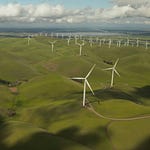In the 2019/2020 fiscal year, the global climate finance sector reached a record 632 billion US dollars. Unfortunately – that is a little short of the more than $3 trillion US dollars needed each year to keep warming under 2 degrees C, according to the IPCC. The Climate Finance Fund (CFF) is a philanthropic organization whose mandate is to close that gap by mobilizing capital towards climate solutions.
How do they do that? CFF focuses on bringing creative climate solutions to market with early investing, and supporting industry-led initiatives and regulatory changes that encourage financial institutions to divest from fossil fuels and invest in clean technology. Managing Director Marilyn Waite joined Climate Now to share the changes CFF’s projects have already brought about, who the big disruptors are in climate finance, and how to get the world’s biggest banks and lenders to take note that it is time to go green.
“Inertia is a hell of a thing, right? Inertia is there and there is very little motivation for an incumbent to change course. So you have to have that disruption from the outside. The same thing with financial services, it’s… like energy, a big incumbent, right? There’s very little motivation to… do anything differently or better, including financing less of the bad stuff and more of the good stuff, unless there is that disruption.” - Marilyn Waite, Climate Finance Fund
Related Content
Episode 39: Green banks: How they unlock funding for climate solutions
Episode 51: Explaining the SEC’s proposed climate disclosure rules
Episode 48: A venture capitalist’s perspective on the evolution of green transportation
Climate Now’s Mini-Explainer Video Series: Scope 1, 2, and 3 Emissions
Full Transcript and References
[00:00:00] James Lawler: You’re listening to Climate Now, I’m James Lawler. Today we’re going to be talking about the role of the financial sector in decarbonizing the global economy. The Banking on Climate Chaos 2022 report found that since the Paris Agreement, the world’s 60 largest private banks financed fossil fuels with 4.6 trillion US dollars — $742 billion in 2021 alone. Despite the fact that wind and solar are on average, cheaper than fossil fuels, and according to our recent podcast guest Doyne Farmer, fossil fuels could be totally priced out of the market in 25 years, major global banks increased their fossil fuel financing from 2020 to 2021.
[00:00:51] Limiting global warming to 1.5 degrees Celsius will require a 30% increase in energy transition investments over what is currently planned. So how do we get more financial investment into the energy transition? Joining us today is Marilyn Waite, managing director of the Climate Finance Fund, an organization whose mission is to answer that question. Marilyn, thank you so much for joining us. I’d love to start by learning about how you got to where you are today in your career, and what kind of work you do with the Climate Finance Fund.
[00:01:23] Marilyn Waite: So I studied civil and environmental engineering, and my first job was in Madagascar, working on water resources, and I experienced firsthand having unreliable electricity for many months.
[00:01:37] And I shifted from water resources towards energy challenges from there. I went to the UK to further study engineering for sustainable development. And then I went to France to really enter the energy sector, nuclear energy, to begin with and eventually renewable energy. And it was in that role, really within corporate R&D that I figured out a lot of our troubles were less on the project management or engineering side, and more on the finance and investment side.
[00:02:11] So I shifted towards finance and investment from there and went to China. I studied business further there. And then I went back to the states to enter the venture capital world. And I led a practice out of Village Capital called clean tech, clean energy. And I decided to focus on improving energy efficiency and goods movement.
[00:02:38] So that’s freight, trucking, rail, you name it. And so I did that focusing domestically in the United States, and then I met Hewlett Foundation and joined them in January, 2018 to lead the climate finance portfolio. Really the goal of the portfolio is to mobilize enough capital to solve climate change. So let’s say we need 3 trillion US dollars each year and investment, we’re only investing just under 700 billion US dollars.
[00:03:11] So how do we begin to plug that gap? So what we’ve done is carved out 75 million US dollars over five years to help with this problem. And about September of 2021, we transferred the portfolio over to the Climate Finance Fund that is being hosted by the European Climate Foundation, it’s being fully funded by the same exact budget and program out of the Hewlett Foundation.
[00:03:36] So that is the gist of where I’ve been in the past. And I skipped over many things in that introduction, but that’s the gist. Probably also worth mentioning is I was also a senior fellow at Project Drawdown. And I oversaw the energy solutions there. And I think that’s important because I think Drawdown has done a great job at communicating the roadmap for getting involved and being a part of the solution for solving climate change.
[00:04:03] James Lawler: Got it. That’s very interesting. So the Climate Finance Fund is now sort of overseeing the portfolio that you mentioned earlier, and the operation is financed with 75 million over five years. What are the projects that you’re involved in there, and what does the work look like?
[00:04:19] Marilyn Waite: Right. So it’s a philanthropic fund, and that means it exists to fund things to go out and finance things.
[00:04:27] And so the work is similar to any other kind of investment manager or fund manager in that there’s a portfolio. And so for each of those pools of capital, whether it’s venture capital, asset management, or bank lending, there are certain initiatives and funds and projects and reports and things of that nature that are part of the portfolio to further the work along with that strategy.
[00:04:54] So at any point in a day, I could be speaking with people in China and Europe and the United States, and any of those pools of capital to deliver a number of things, with regards to mobilizing capital for this. You know, how do we translate this seventy-five-million-dollar portfolio into something that will impact the trillions.
[00:05:16] So we’ve created two pillars. One is innovative finance, and the second is systemic change. On the innovative finance side, you’ll find anything that we can do to prove to the market that something is bankable, investible, financeable, but the market perceives it as not so. For example, we have helped to capitalize a new credit union in the United States called the Clean Energy Credit Union.
[00:05:43] We have participated in blended finance vehicles that bring asset managers to invest in climate solutions and emerging markets. We have supported impact-first venture capital funds. So for example, we were one of the first larger checks into Prime Impact Fund, which then invests in startups whose solutions mitigate climate change at the gigaton level. The second bucket, or pillar, on systemic change — that consists of both industry-led initiatives and regulatory change work.
[00:06:20] So on the industry-led side, you’ll find things like the Partnership for Carbon Accounting Financials or PCAF, which is the financial industry coming together to harmonize their approach by which they measure and disclose and reduce the carbon emissions of their loans and investments. And then on the regulatory side, if you could think about, you know, the alphabet soup of financial regulatory agencies in the United States, for example, you have the federal reserve and the OCC and the NCUA and the FDIC and the CFPB, and they each have a mandate that can be used to ensure that climate risk, opportunity, and impact are accounted for in the financial system. And so we are supporting a number of institutions, whether they be think tanks or others, that are really helping shape new ideas, new policy interventions, new ways of leveraging those mandates, to really make sure the financial system is working for the real economy and working for decarbonization.
[00:07:28] I should also add that all of this, the entire strategy and the pillars, all of it has a JEDI lens, or a DEI lens. So JEDI being the cooler abbreviation, you know, justice, equity, diversity, inclusion. This is all a filter by which we do the work. And we believe that we have to have this filter in order to win on these things because ultimately people are core to ensuring the success of this.
[00:07:54] James Lawler: You mentioned this new Clean Energy Federal Credit Union. And I’m wondering if you could talk about that. What is that federal credit union? What does it exist to do? How does it work?
[00:08:04] Marilyn Waite: Sure. The clean energy credit union, it’s federally chartered, which means anyone can bank with them no matter where they live in the United States, they are a full service credit union, which means they provide banking services, your typical checking and savings and IRAs and CDs, and all of these products for the average consumer and they’re thematic. So all of their loans are around the clean energy economy. So they have the most affordable rates for electric vehicles, ground source heat pumps, solar panels, weatherization upgrades, you name it. They have a whole catalog of interventions, products, and loans that are really catered towards decarbonization at that local level, whether it be residential or small business or community level.
[00:08:56] So they are not only doing this lending themselves. They’re also teaching the credit union ecosystem how to add this new asset class called clean energy to the loan book. So there are over 5,000 credit unions in the United States. And they tend to be one of the most trusted types of financial institutions there are, and what makes them so powerful and important is because they’re often locally embedded, right? They are doing what we might call bread and butter lending, that is absolutely critical for decarbonizing the economy and doing it in a way that is socially just.
[00:09:38] If you are a credit union, you know, in the ecosystem, and let’s just say you were previously heavily involved in taxi medallions. And of course, that’s an industry that’s been disrupted through ride sharing services, and that’s a risky part of your portfolio if you’re a credit union now. And so now you’re thinking, okay, how do I diversify and remain healthy as a financial institution?
[00:10:00] Well, here comes this new thing called clean energy that is attractive in many ways. The Clean Energy Credit Union has had zero defaults since its inception, which is amazing. I mean, zero defaults, and we find that there are these high quality loans that are available. And so what a credit union can do is buy a loan participation from Clean Energy Credit Union, start to become more familiar with the asset class, and then start the origination themselves. So it’s really an on-ramp to scaling clean energy finance.
[00:10:34] James Lawler: And in terms of the loans that prevail today in the clean energy space, what’s the breakdown of people who are borrowing for clean energy projects right now. Is it individuals, is it companies, like who’s sort of the typical borrower for clean energy projects?
[00:10:48] Marilyn Waite: Well, credit unions mostly serve households or individuals or residential scale. Whereas a lot of the banks, they tend to focus more on businesses.
[00:11:00] James Lawler: And how much demand among that kind of demographic, like household investments in clean energy projects, how much has that grown?
[00:11:07] Marilyn Waite: So we know that there were roughly 31,000 homes in the US with solar in 2006, and in 2021, there were over 3 million. So there’s clear market growth and demand. And we also know that there are over 280 credit unions in particular that are involved in green lending. And of course the potential is many times that, with just under 6,000 credit unions being available and growing, right? So this has been an overlooked part of the ecosystem, but it is clearly the answer or part of the answer, for scaling things like solar, EVs, ground source heat pumps, and other interventions that decarbonize at the decentralized level, which is what we need.
[00:11:56] James Lawler: That’s really amazing, really interesting ecosystem that really anyone can participate in, which I don’t know that many people really know that. Going back to your two pillars, and staying with the innovative finance pillar for a moment, you supported a number of impact first venture capital funds. And I wonder what is the typical VC ecosystem look like? And then what is this impact-first VC ecosystem? And how does that actually work in terms of their investors?
[00:12:23] Marilyn Waite: So venture capital, if you think about different pools of capital that are out there and you place them on a risk spectrum and a deal size spectrum, the venture capital grouping would be the smallest bubble right on the graph.
[00:12:38] So it is the least amount of capital available in the ecosystem compared to, for example, bank lending or asset management through the public markets, like through stocks and bonds. And that’s partially because it is the most risky, right? It is something that takes on the most risk. It expects returns for that risk, of course, but it is very high risk in that, especially at the early stages when you are investing with that very little track record.
[00:13:07] So we are seeing a rebirth right now of venture capital interested in what we’ve calling climate tech. And that’s technologies that are mitigating climate change, helping us adapt to climate change, or helping us understand better climate change. What makes venture capital so important is that because it’s taking on more risk, it’s the only kind of capital that really can address some of the hard to abate areas like steel, cement, chemicals, like carbon dioxide removal.
[00:13:42] And so even though it’s in the shortest supply, it does have an outsize impact because it can take on more risks.
[00:13:52] James Lawler: And what is the Climate Finance Fund’s thesis when it comes to making an impact in the venture capital space?
[00:14:00] Marilyn Waite: So the two things that we’ve done that are worth mentioning: one is of course, helping to seed and scale a new gigaton focus fund that is not afraid of hardware and that embraces it. That will go and invest in startups that are solving problems or mitigating CO2 in difficult ways. Like the Prime Impact Fund. So that is one thing, because a lot of capital-light or software focused parts of this, which are important, they have an easier time in attracting capital.
[00:14:36] Because they have capital-light solutions. So that’s one way we are supporting. The second way is that we have helped to create this ecosystem around climate FinTech. And so we supported New Energy Nexus to create this report around the landscape of climate FinTech, to define it, to understand what exactly is it, how does it work in China, Europe, and the United States.
[00:15:01] What are the areas that receive the most capital, the areas that receive, the least, what kinds of things do they actually solve in the real economy, and then to have a kind of a pilot accelerator focusing on climate FinTech. And so they ran an accelerator in partnership with Barclays and MasterCard and Dichotomy and Patch, and they were able to award non-dilutive capital to four startups in climate FinTech, including a startup called Ecountabl in the US. That helps bring transparency to users and their transactions. It’s an app where you can actually see ‘oh, this product A versus product B, or this coffee shop A versus coffee shop B. This one is actually more aligned with climate action, are more aligned with the values that I’ve chosen, and so let me further support this one,’ and start to send those feedback messages to the laggards in the system as well. And so that’s an example, also supported in neo-bank in France called Green Got, which is similar to Aspiration in the United States, in that they’re a fossil fuel free FinTech company that’s serving as a bank with banking services. And so this ecosystem of climate FinTech is important because, kind of similar to the energy sector where the energy sector is full of incumbents and difficult to disrupt, but we have to have a disruption, right, in order to decarbonize. So we had to have wind and solar and geothermal and all of these micro-scale hydro, in-stream hydro, come in and disrupt.
[00:16:36] And without that, we probably would not have seen the market uptake that we have. And we probably need to have more of it to go even further because inertia is a hell of a thing, right? Inertia is there and there’s very little motivations for an incumbent to change course. So you have to have that disruption from the outside. The same thing with financial services, it’s also like energy, a big incumbent, right?
[00:17:05] There’s very little motivation to change anything or to do anything differently or better, including financing, less of the bad stuff and more of the good stuff, unless it’s that disruption. So climate FinTech plays a very important role in being a disruptor that can actually drive capital away from dirty energy, towards clean energy.
[00:17:26] And if you look at the whole drawdown set of solutions, away from all of those activities that produce greenhouse gases, towards those that actually mitigate.
[00:17:36] James Lawler: Yeah. And I think maybe that’s a segue toward a fascinating report called Banking on Climate Chaos, which essentially details the large private banks’ investments in fossil fuels.
[00:17:50] This essentially represents the inertia that climate and clean technology financing is potentially up against. But if you wouldn’t mind describing sort of the scale of this inertial force in terms of financing fossil fuels and how we might change this picture.
[00:18:08] Marilyn Waite: Yeah. So calling this one inertia would be giving them too much credit I think. So the Banking on Climate Chaos report, which is an annual report by a coalition of civil society organizations, or non-governmental organizations, is really important in that they track and report the fossil fuel financing of the largest 60 banks in the world. And they also have a typology of the kind of fossil fuel as well.
[00:18:39] So right, the tar sands, and the Arctic drilling, and all the things in enough granular detail. And what we’ve found over the many years that they’ve been tracking is that consistently the worst banks in the world, when it comes to financing the climate crisis, the top four, are all US retail banks.
[00:19:00] So that means these banks are serving the everyday person, and they are JP Morgan Chase, Citi, Wells Fargo, and Bank of America. Collectively, there has been 4.6 trillion US dollars financed by the global banks into fossil fuels since the Paris Agreement was signed. And what makes the analysis particularly troublesome is that it’s not just inertia.
[00:19:25] It’s not just financing the continual operations of existing infrastructure. There has been concrete expansion. So these financiers are actually helping expand fossil fuels in ways that go way beyond just maintaining the status quo, right? And so we have also supported the creation of the Bank for Good dot org platform.
[00:19:53] If you go to bankforgood.org, if you’re in the United States, you will find a list of fossil fuel free, climate friendly banks and credit unions. And you can filter by all kinds of preferences. And that is one way of saying, okay, there is all of this destructive finance, right? And there’s an opportunity for us all, as people and as institutions to choose those banks that are not financing the climate crisis.
[00:20:23] James Lawler: That’s really very interesting. And we’ll make the link to the Banking on Climate Chaos report available, as well the bankforgood.org website. So just moving to the other pillar of your work, there’s so much that you do, I mean, we only covered one pillar so far. The system change side. You mentioned that some of your work has focused on supporting the partnership for carbon accounting financials, developing more standardized methodologies for carbon reporting.
[00:20:53] What is the current state of affairs when it comes to carbon accounting, and what is the progress that is currently underway to improve that?
[00:21:02] Marilyn Waite: Yes. So the partnership for carbon accounting financials, PCAF, now has over 240 banks and asset managers that represent over $60 trillion of assets, measuring, disclosing, and reducing their finance emissions via this methodology.
[00:21:25] And we have seen uptake by a number of important other initiatives, and by regulation. So the TCFD, which is the task force on climate-related financial disclosures, they have called on PCAF as a standard in their metrics recommendations, so how do the banks and the asset managers and so on actually count the carbon.
[00:21:53] And so it’s been an important ecosystem change-maker that way. The European Banking Authority, or the EBA, they have used this to require all of the banks in Europe to measure and disclose their finance emissions via this method by 2024. The SEC recently issued a draft climate disclosure rule. And we expect that in order to fulfill those disclosure obligations, a lot of financial institutions will be using the PCAF methodology.
[00:22:28] So that is an example of something that, you know, started off industry-led, that is industry-led in many ways, and is having an impact way beyond just kind of being a voluntary method to measure, disclose, and reduce finance emissions. It’s also worth mentioning that when we supported bringing this to the US from — it started in the Netherlands– so bringing it out of the Netherlands and to the US and globally, we actually started with the banks and credit unions that are sustainable and have ESG in their DNA.
[00:23:02] We didn’t start with the big laggards, we started with Clearwater Credit Union. We started with self-help credit union, amalgamated thing. Like those that are actually interested and aligned with having the strongest, most robust, most impactful methodology and standard, as opposed to those who might be more interested in having something that’s very watered down. The traditional method has been, ‘oh, well you just get, you know, get a big plate or sign up and then you’re done. like, then everyone else will follow.’
[00:23:35] What that has meant though, especially in this space in the past, is that what ends up being produced is not very impactful. And therefore we did the opposite, right? We were more concerned about the integrity of the method and what was being required, then of having, you know, a shortcut way to scale.
[00:23:56] And I think that’s an important lesson that I would love to share with anyone that’s working on systems change, anyone in the philanthropic community. Because really, I think there’s been an enormous bias to our detriment over the big fancy thing, as opposed to the grassroots bottom up, go with who’s dedicated in the beginning, and then scale that way approach.
[00:24:22] James Lawler: That’s such a great story. This idea that this standard, the PCAF standard, was developed in a more sort of grassroots way in partnership with folks who really cared about rigor, outcome, as opposed to, you know, developing something top down, that’s more watered down and not as stringent, is a really very interesting approach.
[00:24:46] So thanks for highlighting that. And it seems as though this standard applies across all different financial activity, from commercial real estate, mortgage, different types of loans, project finance, and is really sort of a comprehensive standard that we might expect financial institutions to adopt as these SEC rules come into effect.
[00:25:07] Marilyn Waite: Right. If you go on the PCAF website, which is carbonaccountingfinancials.com, you can already see the institution is taking action, and you can filter by the region so you can choose North America and you will see, I mean, there’s a $10 trillion asset manager, right? You’ll see the scale. You’ll see regional banks, you’ll see small credit unions. I mean, this is super inclusive.
[00:25:34] James Lawler: What’s also really fascinating about this website is that you can filter by the data-first disclosure and see how these standards are taking effect. There were basically three institutions in 2018 that disclosed for the first time. And it doesn’t look like there was much disclosure before that.
[00:25:47] And now we’re only through about the first half of 2022. And this year you have 20 disclosures already as of the date of recording of this episode, which is most of the way through the first quarter of 2022, you have about 20 disclosures already. It feels as if the writing’s on the wall here. Like if you’re not disclosing already, you better jump on that bandwagon because it’s going to be something that everyone’s going to have to do pretty quickly. But what do you think the effect of this will be Marilyn? How do you think this will impact investment in fossil fuels and so forth?
[00:26:15] Marilyn Waite: So I think it motivates better behavior and meaning less carbon-intensive financing and more green lending, green financing. But I don’t think that alone will get us where we need to go.
[00:26:28] So it’s an important basis. When I first started this work, I had just assumed we already had this data. It just seems so basic. Right. But we didn’t. We’re so behind, I mean, this should have been done decades ago. We weren’t paying attention to the engine behind the entire economy.
[00:26:48] James Lawler: That was Marilyn Waite, who’s work with the Climate Finance Fund is greening the financial sector from the system-scale down to individual bankers. Marilyn is also the author of the book “Sustainability at Work: Careers that make a difference”. You can find a link to more details about her book as well as links to the Banking on Climate Chaos report, bankforgood.org, and the PCAF website at climatenow.com.
[00:27:10] You can also listen to our other interviews, watch our videos, or sign up for our newsletter. Climate Now is made possible in part by our science partners, like the Livermore Lab Foundation, the Livermore lab foundation supports climate research and carbon cleanup initiatives at the Lawrence Livermore National Lab, which is a Department of Energy applied science and research facility.
[00:27:30] More information on the foundation’s climate work can be found at livermorelabfoundation.org.












Financial innovations for climate and clean energy impact